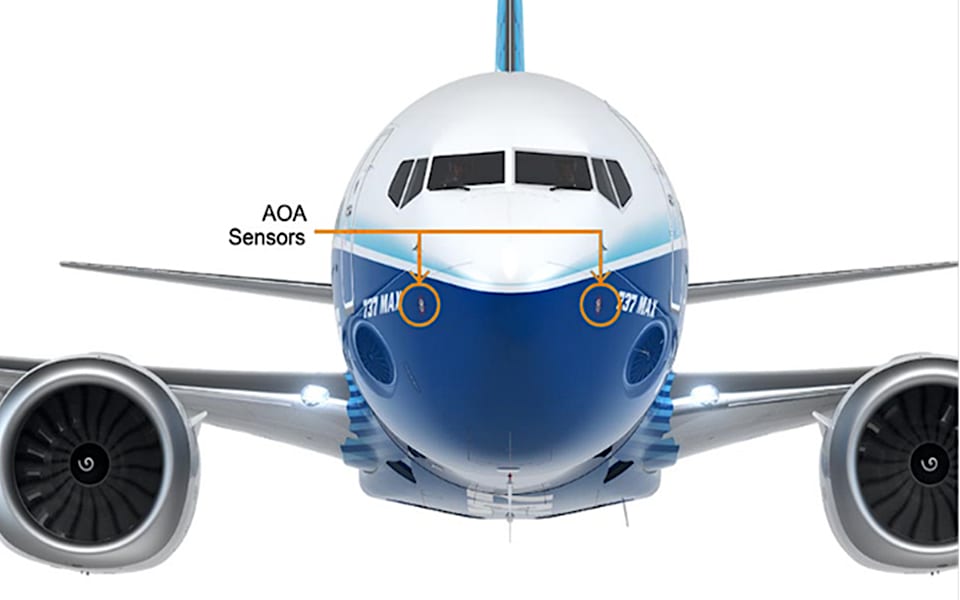
During their first quarter 2020 earnings call, Boeing’s chief executive provided updates on their work to return the 737 MAX to passenger-carrying service. At present, Boeing is awaiting software validation for the MAX’s flight control computer, separate from the aircraft’s MCAS system, which manages the aircraft’s angle of attack (AOA) sensors, pictured here. Photo: Boeing
A certification flight required to clear the grounding on the 737 MAX is awaiting software validation, with Boeing CEO Dave Calhoun anticipating a third quarter return to service, according to the company’s Apr. 29 first quarter earnings call.
The certification flight awaits software validation for the 737 MAX flight control computer (FCC). Calhoun gave no timeline on when the software validation effort would be complete.
“Right now we’re focused on completing the software validation and required technical documentation that will precede a certification flight, some of the documentation work has taken longer than we expected,” Calhoun said. “And the coronavirus situation has also required some changes to how we do things, including working remotely and virtual meetings with our regulators.”
A representative for Boeing provided an emailed statement to Avionics explaining the software issues that the 737 MAX program has been working through in recent months. According to the representative, the software validation effort focuses on a modification that was made to the flight control computer that is not associated with the MAX’s highly scrutinized Maneuvering Characteristics Augmentation System (MCAS).
The two features in focus include the computer’s microprocessor and autopilot engagement.
“The first issue involves hypothetical faults in the FCC microprocessor, which, in theory, could potentially lead to a runaway stabilizer. While these particular faults have never been observed in flight, the software modification will eliminate the possibility of those faults occurring. The second issue with the FCC could potentially lead to disengagement of the autopilot feature during final approach. While this has also never been observed in flight, and flight deck alerts and warnings are already in place to alert the crew if it did, the software update will prevent this fault from occurring,” the representative said.
Both issues were recently identified by Boeing and solutions are being incorporated at the same time.
The software associated with the 737 MAX flight control system has been an issue for the program’s return to service since at least November, when an article published by Reuters featured a statement from the European Aviation Safety Agency (EASA) seeking a revision to the software documentation.
Boeing’s 737 MAX 8, the aircraft type used for Ethiopian Airlines flight ET 302, features an enhanced digital flight control system with software that manages functionality of MCAS, emergency descent in autopilot and flight level change mode, spoiler control electronics interface and autopilot roll command alerting system according to the interim report published by Ethiopia’s Ministry of Transport last month. The software version featured on the ET 302 MAX featured an MCAS flight control law that will command stabilizer nose down trim if it receives an AOA condition value that exceeds the threshold at which the computer senses the airplane approaching a stall condition.

An overview of the digital flight control system featured on the MAX. Photo: Ethiopia Ministry of Transport
“Validation is the process of ensuring that the requirements are sufficiently correct and complete,” investigators said in the interim report. “Verification is the process of ensuring that the final product meets the design requirements. Verification activities may include analysis and testing the individual item of equipment (e.g. flight control computer software) and then progressively integrating the equipment into a complete system and even flight testing for verification of a fully integrated system on the aircraft.”
Changes Boeing has made to the MCAS functionality include a new dual sensor feed that will compare data from both AOA vanes, instead of relying on one. Under the new update, the system will only activate a single time and will never provide more input than a pilot can counteract using the control column alone.
Calhoun further clarified any existence of a software glitch associated with the MAX flight control computer – separate from the MCAS system – during an interview on CNBC prior to the earnings call.
“There is a mountain of documentation that has to be completed,” he said. “Sometimes, the documentation work is confused with what is referred to as a software glitch. We have not had software glitches in the performance of our airplane at all on our test flights or otherwise. So, we are going to complete the documentation.”
On the earnings call, Boeing Chief Financial Officer Greg Smith also confirmed that the 737 MAX has completed more than 1,000 flights over the last year. The temporary suspension of 737 MAX production implemented by Boeing in January remains in place for now, with Smith noting it could be lifted and a lower production rate re-opened within the next few months.
“We’ve assumed that we will begin 737 MAX aircraft production at low rates during the second quarter of 2020, as timing and conditions of return to service and COVID-19 impacts are better understood,” Smith said. “We expect to gradually increase the production rate to 31 during 2021 and expect further gradual increases to correspond with market demand.”